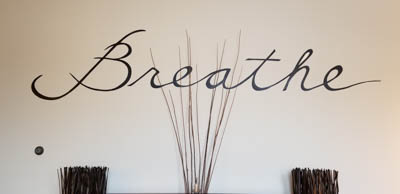When Air Becomes Breath

In his inspiring memoir, When Breath Becomes Air, brilliant neurosurgeon resident, Paul Kalinthi, tracks his existential, spiritual, and physical journey through life into death. Death- that point in time when the breath that once sustained life becomes, once again, only air.
In life, the opposite is true. What exists in the universe as air, when taken in by living beings, is transformed by the natural process of breathing into energy that sustains life. When done consciously, breath can enhance health and well-being.
“Studies are revealing that, by changing the patterns of breathing, it is possible to restore balance to the stress response system, calm an agitated mind, relieve symptoms of anxiety and PTSD; improve physical health and endurance, elevate performance and enhance relationships.”
Drs. Richard Brown & Patricia Gerbag
Breath is an assumed and integral part of being alive, until or unless it is challenged by illness or accident. Governed largely by our autonomic nervous system (ANS), the auto pilot of our nervous systems, we are largely unconscious of our own breathing. We’ve never not done it and are usually unaware that we are breathing at all.
What we do notice, though, are the byproducts of our breathing. Tight muscles. Shoulders drawn taught towards our ears in tension. Dizziness. Racing thoughts. Tingling in arms, hands, legs and feet. A sense of imminent doom or death. We can even pass-out.
“Well, those all sound like symptoms of anxiety and stress”, you might say. They are. Anxiety, stress, and breathing are intricately related in a game of round robin. Anxious thoughts trigger shallow breath akin to hyperventilation, which then contributes to increased anxiety as the felt sense of trust in our physical self is diluted by the feeling of loss of control.
The merry-go-round of misery goes ‘round and ‘round.
Oddly, the cure is embedded in the curse itself…breath.
“The most obvious and immediate way to feel less anxious is by changing how you breathe. You can literally reverse your body’s stress response by changing how you breathe.” Mary Nurrie Stearns, LCSW & Rick Nurrie Stearns
Breath is governed by our autonomic nervous systems, but can be influenced by voluntary control.
You recall that our autonomic nervous system is that part of our human anatomy that is behind the scene directing the show. Functions like respiration, heart rate, and brain waves are all under the control of the ANS and happen outside of our awareness.
The ANS has two primary branches, the sympathetic (SNS) and the parasympathetic (PNS) nervous systems. The SNS prepares us for the fight or flight response to danger, threat, or the challenge of heightened performance. When activated the heart rate and brain waves speed up and blood is shunted to the extremities fueling us for movement. Cortisol and adrenaline levels rise, quickening our response time and we are co-opted into a full fledge stress response.
In and of itself, the stress response system is designed for our own protection and well-being, alerting us to danger or demand and equipping us to respond. Fight, flight, freeze, tend and befriend are nature’s lifesaving mechanisms, guarding our health and well-being.
Stress and anxiety can activate this system. It causes distress, however, when it is uninterrupted by the calming influence of the PNS.
The PNS conversely, quiets our system down and creates the relaxation response that Dr. Herbert Benson introduced us to years ago. The role of the PNS is to slow down respiration, heart rate and to direct blood to the digestive and sexual organs. As the heart and respiration calm and slow, so do our anxious brains and bodies.
The SNS and PNS operate in relative dominance. Like a see-saw, when one is up, the other is down. We can influence a shift in this system through our breath.
“Your breathing and heart rate are interconnected. As you learn to breath more deeply, your heart rate will slow and you can enjoy a calm, clear frame of mind.” John Arden, PhD.
I have grown up to be like my father. Ask me the time and I will tell you how to build a watch. Yet, the importance of breath work in creating balance and health is so vitally important to me that I wanted to start from the ground and work our way up as we look at the healing power of breath work on anxiety and stress. As a therapist working with clients whose lives are burdened by anxiety and stress, and not being immune to these feelings myself, I am devoted to teaching the power of a simple breath in restoring health and well-being.
Future articles will look at the process of breathing, the use of breath in meditative practices, and guidance on developing a breath practice for yourself as we go about the business of Practicing Peace on Purpose.
I hope that you will join me.
Photo compliments of Marsha Needham, LMT


